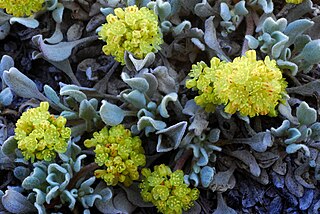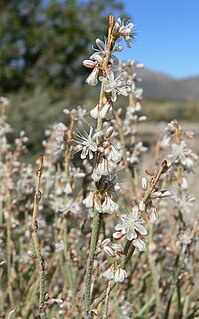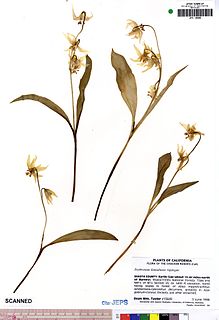
Eriogonum alpinum is a species of wild buckwheat known by the common name Trinity buckwheat.

Eriogonum diclinum is a species of wild buckwheat known by the common name Jaynes Canyon buckwheat. It is native to the Klamath Mountains of northern California and southern Oregon, where it is an uncommon member of plant communities on serpentine soils. This is a small dioecious shrub forming low, thick mats rarely exceeding 20 centimeters in height. The curving, oval-shaped leaves are woolly and greenish gray in color, growing up to two centimeters long. The plant flowers in yellow to reddish rounded inflorescences, male plants producing clusters of staminate flowers, and female plants producing larger clusters of pistillate flowers.

Eriogonum libertini is a species of wild buckwheat known by the common name Dubakella Mountain buckwheat. This uncommon plant is endemic to California where it grows in the rocky serpentine terrain of the southern Klamath Mountains and nearby ranges.

Eriogonum marifolium is a species of wild buckwheat known by the common name marumleaf buckwheat. It is native to the Sierra Nevada and Klamath Mountains of California and the ranges' extensions into Oregon and Nevada.

Eriogonum microthecum is a species of wild buckwheat known by the common name slender buckwheat. It is native to the western United States where it is found in a variety of habitats, particularly in dry areas such as deserts.

Eriogonum rosense is a species of wild buckwheat known by the common name rosy buckwheat. It is native to the mountains of eastern California and its range extends into Nevada.

Eriogonum umbellatum is a species of wild buckwheat known by the common name sulphurflower buckwheat, or simply sulphur flower. It is native to western North America from California to Colorado to central Canada, where it is abundant and found in many habitats, including the sagebrush steppe and alpine areas. It is an extremely variable plant and hard to identify because individuals can look very different from one another. Also, there are many varieties. It may be a perennial herb blooming by summer with stems 10 centimeters tall and two to six clusters of flowers, with a whorl of leaves below the stems, or a sprawling shrub approaching two meters high and wide. The leaves are usually woolly and low on the plant, and the flowers come in many colors from white to bright yellow to purple. Native American groups utilized parts of this plant for a number of medicinal uses.

Eriogonum ursinum is a species of wild buckwheat known by the common names Bear Valley buckwheat and talus buckwheat. It is endemic to northern California where it is found on mountains from the northern Sierra Nevada to the southern Klamath Mountains.

Eriogonum butterworthianum is a rare species of wild buckwheat known by the common name Butterworth's buckwheat. It is endemic to the Santa Lucia Mountains of central Monterey County, California, where it is known from a few occurrences in the wilderness southeast of Big Sur in the vicinity of Junipero Serra Peak. Its native habitats include oak and conifer woodlands, chaparral communities, and sandstone outcrops. Eriogonum butterworthianum is a small clumpy shrub or subshrub that grows up to about 30 centimeters tall and wide. Leaves are 2 centimeters long and reddish-green in color. They are woolly, oval in shape, and curled under at the edges. The inflorescence is a cluster of flowers up to 2 or 3 centimeters wide. Each individual flower is a few millimeters wide and dull yellowish to pinkish in color. Flowers bloom June to September.

Eriogonum congdonii is a species of wild buckwheat known by the common name Congdon's buckwheat. It is endemic to the Klamath Mountains of northern California, where it is an uncommon member of the serpentine soils flora in the local forests. It is a low, matting shrub growing up to about half a meter wide and tall. The woolly leaves are widely lance-shaped and are found along the stems, especially in clusters at the stem tips. The inflorescence is an erect, dense umbel of many tiny bright yellow flowers.

Eriogonum eremicola is a rare species of wild buckwheat known by the common names Telescope Peak buckwheat and Wild Rose Canyon buckwheat. It is endemic to Inyo County, California, where it is known from only a few occurrences in the Inyo Mountains and Telescope Peak in Death Valley. It grows in sandy to rocky habitat in the forests and woodlands of these desert mountains. It is an annual herb producing a spreading, glandular, reddish green stem up to about 25 centimeters tall. The rounded, woolly leaves are up to about 2.5 centimeters long and are located at the base of the stem. The scattered inflorescences are small clusters of tiny flowers which are white with reddish stripes, aging to solid red, or sometimes yellow. The plant is under protection in Death Valley National Park.

Eriogonum panamintense is a species of wild buckwheat known by the common name Panamint Mountain buckwheat. It is native to several of the desert mountain ranges of eastern California and western Nevada, including the Panamint Range. It grows in various types of mountain ridge habitat, such as sagebrush and coniferous woodland.
Eriogonum pendulum is a rare species of wild buckwheat known by the common name Waldo buckwheat. It is endemic to the Klamath Mountains of Josephine County, Oregon, and Del Norte County, California, where it is a member of the serpentine soils flora.

Eriogonum siskiyouense is a rare species of wild buckwheat known by the common name Siskiyou buckwheat.

Erythronium klamathense is a rare species of flowering plant in the lily family known by the common name Klamath fawn lily. It is native to northern California and southern Oregon, where it grows in the Klamath Mountains and the southernmost peaks of the Cascade Range.

Rudbeckia californica is a species of flowering plant in the family Asteraceae, known by the common name California coneflower.
Silene salmonacea is a rare, newly described species of flowering plant in the family Caryophyllaceae known by the common names Klamath Mountain catchfly and salmon-flowered catchfly. It is known only from Trinity County, California, where it grows in the forests of the southern Klamath Mountains. It is a member of the serpentine soils flora. It is a small perennial herb growing just a few centimeters tall. The spoon-shaped leaves are up to 3.5 centimeters long. The herbage is gray-green and lightly woolly in texture. Each flower has a tubular calyx of fused sepals lined with ten veins. There are five salmon pink petals, each with four lobes at the tip.

Eriogonum callistum is a rare species of wild buckwheat, known by the common name Tehachapi buckwheat.
Eriogonum coloradense is a species of flowering plant in the buckwheat family known by the common name Colorado buckwheat. It is endemic to Colorado in the United States.

Eriogonum soredium is a species of wild buckwheat known by the common name Frisco buckwheat. It is endemic to Utah in the United States, where it is known only from Beaver County. There are four populations, all located in the San Francisco Mountains. It is a candidate for federal protection.


















